10.2-Tuesday- Appomattox National Historic Park
Today looks to be another beautiful day with temps reach no higher than 77 degrees. Our destination is Appomattox Court House (2-words) and Museum. To explain the 2-word item. “Courthouse” refers to just that a court house while a “Court House” makes reference to the county seat; FYI! 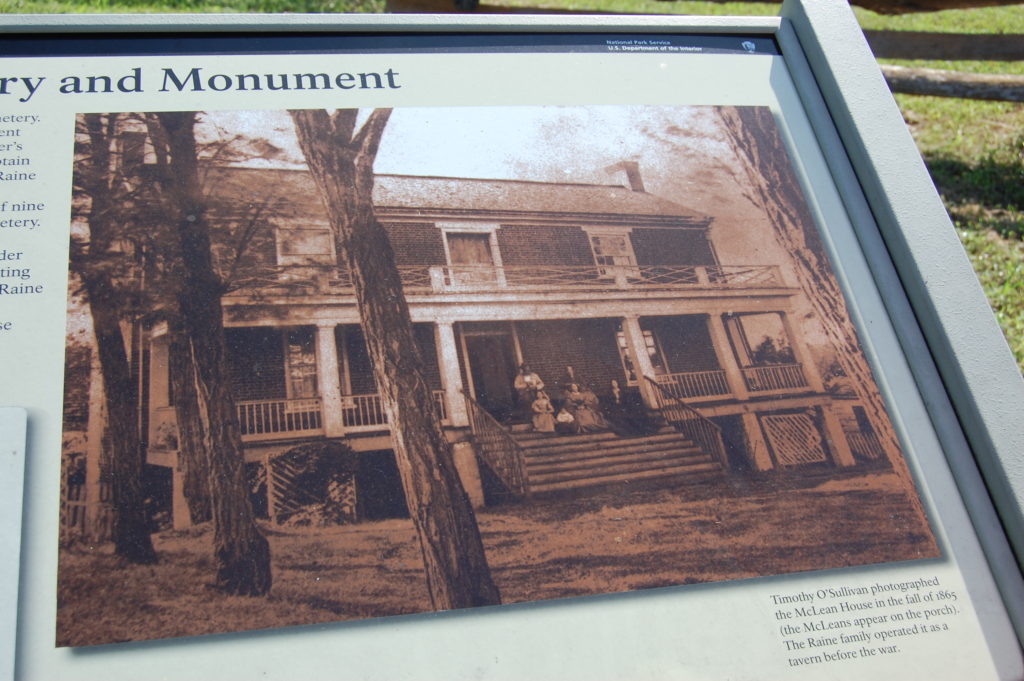
This is the actual looks of the McLean House. It was in this house and location that the signing of the surrender of General Lee took place with General Grant.
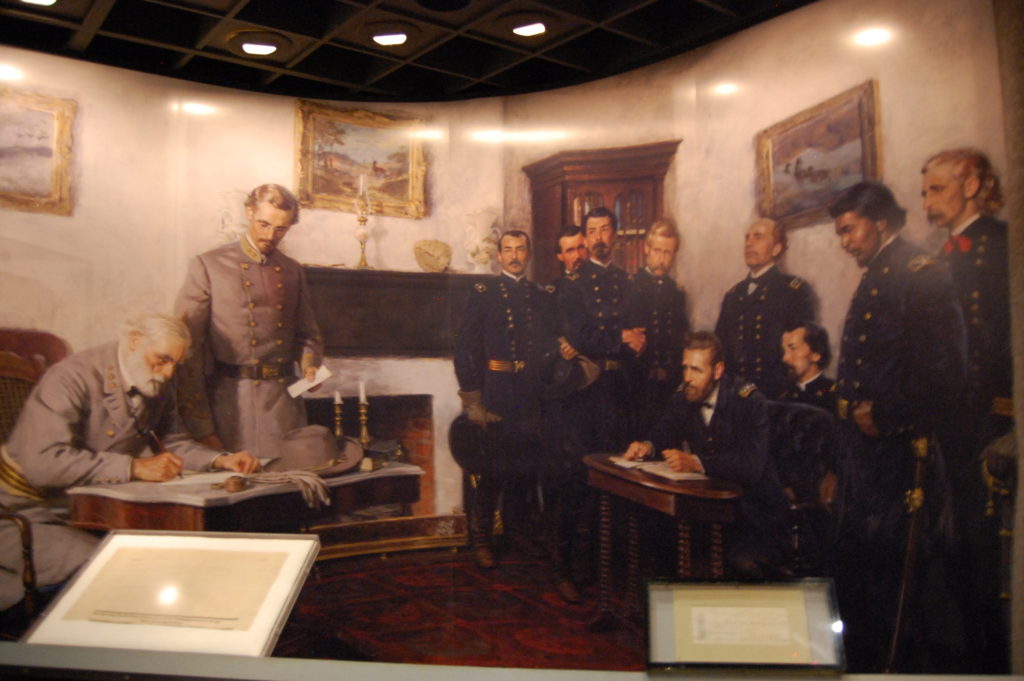
There’s so much to this venue this is just an intro to our visit there. I should have a blog or possibly a pictorial on this venue in the next day or so. I’m fairly certain that the plaques below will reintroduce you to this part of our history.
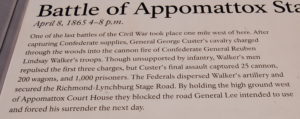
In April in 1865 as many as 65,000 troops were encamped on these grounds.
Below just a little history on this part of our history. It would have been to much of an ordeal for me to try to summarize what the National Park Service has already articulated in the text to follow. The NPS text is in bold / italicized print. If the print you see is not BOLD and not italicized then those words are mine commenting on the pictures either above or below my text.
General Robert E . Lee realized that the retreat of his beleaguered army had finally been halted, U. S. Grant was riding toward Appomattox Court House where Union Cavalry, followed by infantry from the V, XXIV, and XXV Corps had blocked the Confederate path.
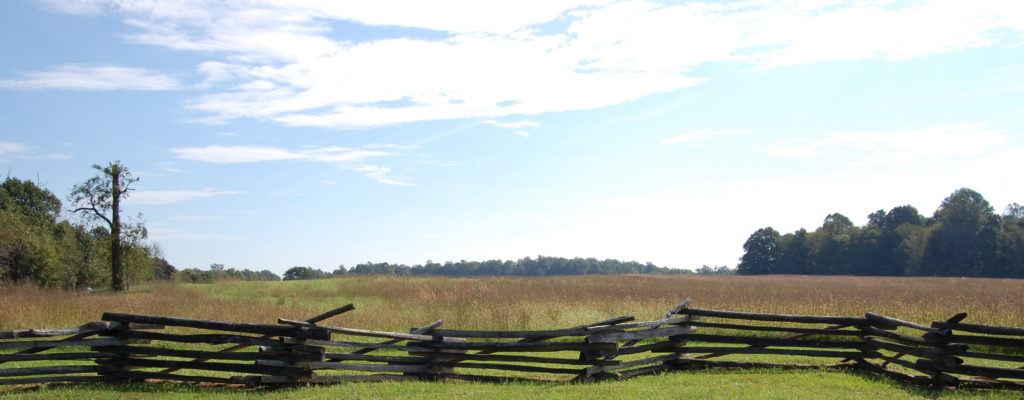
The field just about a half mile from the McLean House when up to 65,000 troops were encamped both on this side of the road and the other.
Lee had sent a letter to Grant requesting a meeting to discuss his army’s surrender and this letter overtook Grant and his party just before noon about four miles west of Walker’s Church (present-day Hixburg).
Over to the right in this field is a path that we’re directed to experience.
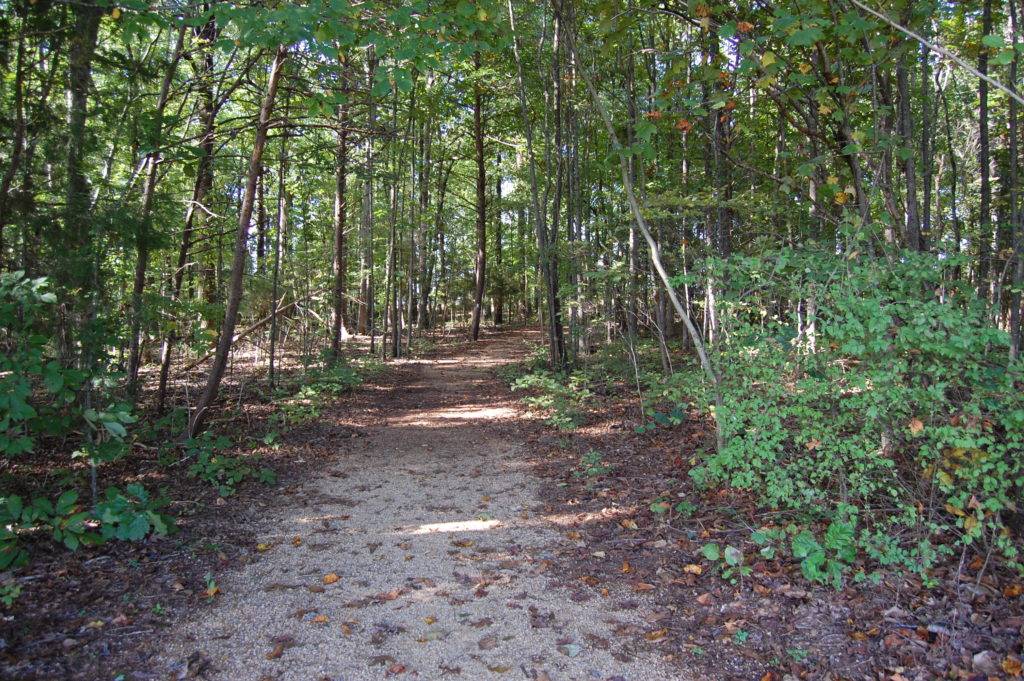
Grant, who had been suffering from a severe headache, later remembered that upon reading Lee’s letter the pain in his head had disappeared. He stopped to prepare his reply to Lee, writing that he would push to the front to meet him.
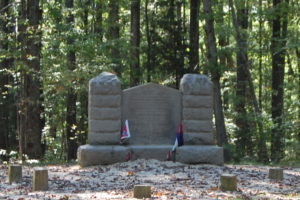 A monument dedicated to the Confederate soldiers, mostly North Carolina, in the battle in this area.
A monument dedicated to the Confederate soldiers, mostly North Carolina, in the battle in this area.
The location of the meeting was left to Lee’s discretion. After reading Grant’s letter, Lee, his Aide-de-Camp Lt. Colonel Charles Marshall, and Private Joshua O. Johns rode toward Appomattox Court House Marshall and Johns rode ahead of Lee in order to find a place for the generals to confer.
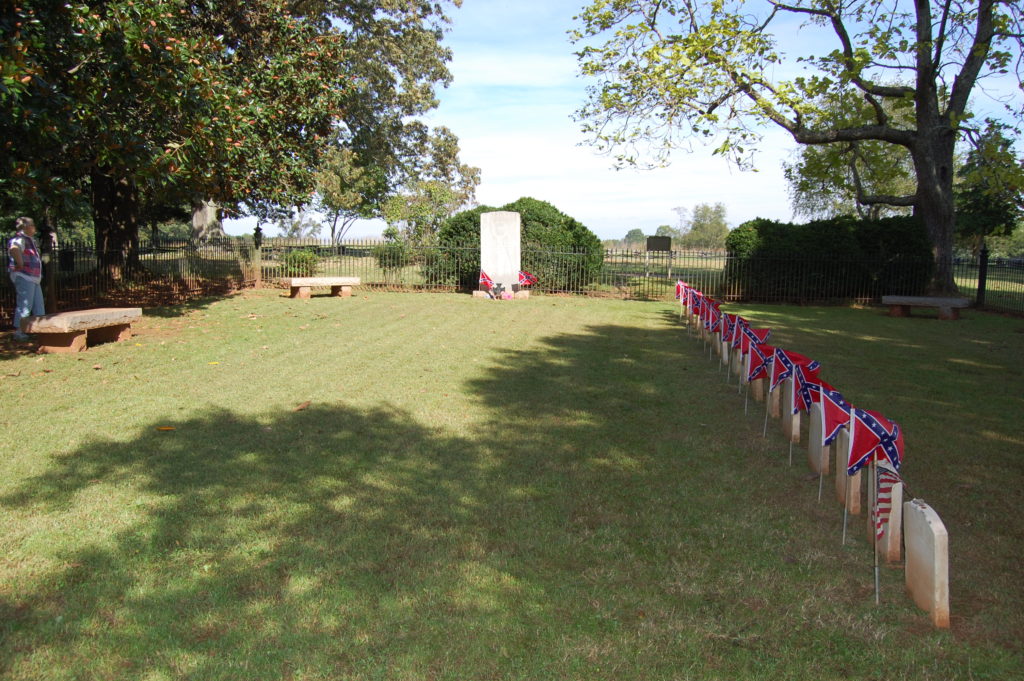
In those times, around 1865, those who died in battle were generally buried where they had died. In the 1960’s the government decided to have a special cemetery plot for those that died. As you can tell they could only find the remains of a little more than a dozen men. All but one were Confederate soldiers. You’ll notice the first monument which bears the Union Flag was a Union soldier.
As Marshall passed through the village he saw Wilmer McLean in the vicinity of the courthouse. He asked McLean if he knew of a suitable location. Then McLean offered his own home.
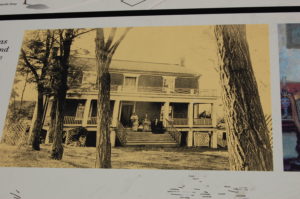
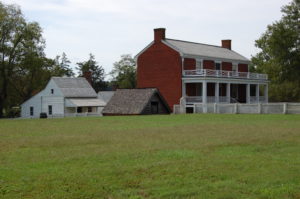
Above. The picture on the left is the McLean house in 1865, the one on the right is the current version of that house with 150 years of improvements.
After seeing the comfortable country abode, Marshall readily accepted and sent Private Johns back to inform General Lee that a meeting site had been found.

At first I thought this was an early picture of the Surrender Event, then I realized that “colored pictures” would be way into the future. But, none the less, as you enter the McLean home to the left is this room. It contains many of the original furniture but the signing desks are reproductions. The real stuff is in a national museum.
Lee arrived at the McLean house about one o’clock and took a seat in the parlor. A half hour later, the sound of horses on the stage road signaled the approach of General Grant. Entering the house, Grant greeted Lee in the center of the room.
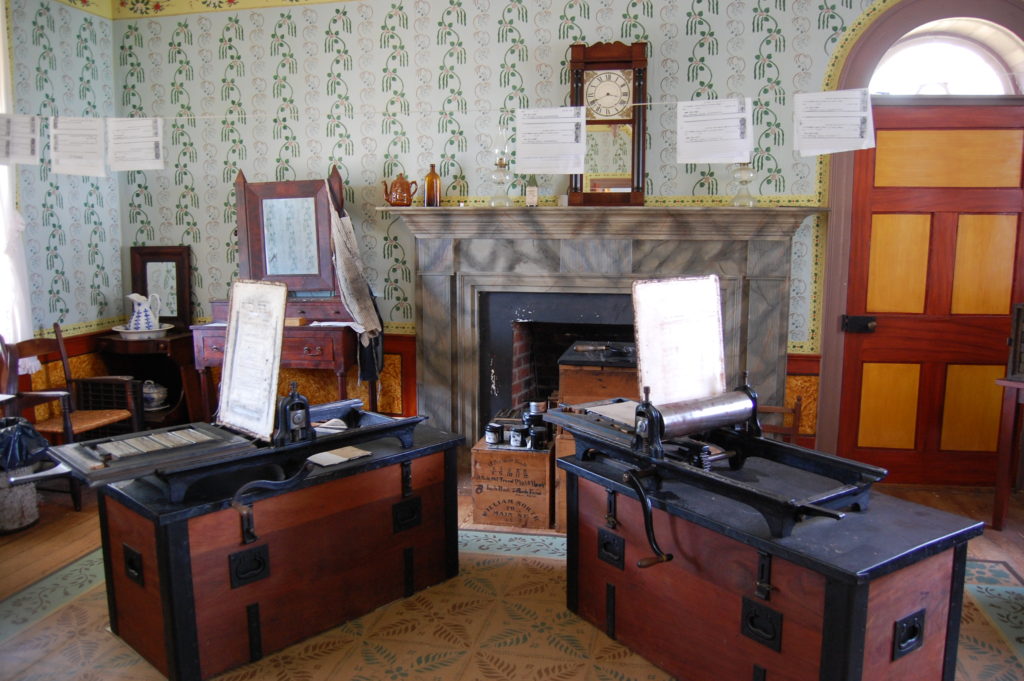
The day after the Surrender signing it was decided that the Confederate soldiers should have parole papers for his men to carry with them so as not to be assumed to be deserters. So the immediately got three presses, 2 are shown, and began drawing up over 35,000 forms for the confederate men.
The generals presented a contrasting appearance; Lee in a new uniform and Grant in his mud-spattered field uniform. Grant, who remembered meeting Lee once during the Mexican War, asked the Confederate general if he recalled their meeting.
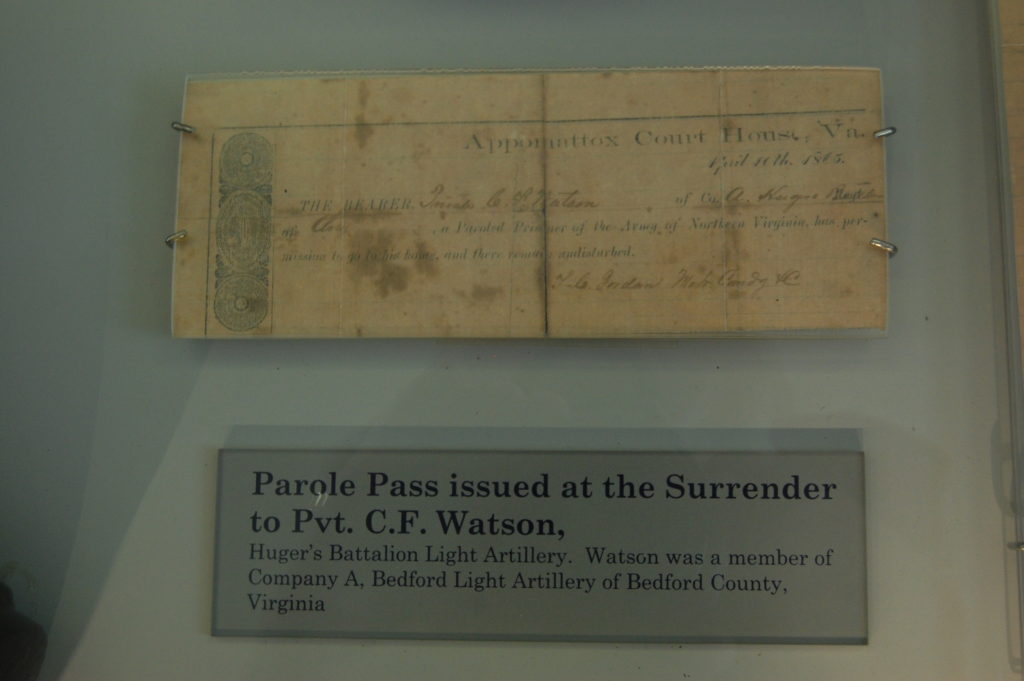
A Parole Pass for C F Watson. This picture is the best I could do, remember this pass is over 150 years old.
Lee replied that he did, and the two conversed in a very cordial manner, for approximately 25 minutes. The subject had not yet gotten around to surrender until finally, Lee, feeling the anguish of defeat, brought Grant’s attention to it. Grant, who later confessed to being embarrassed at having to ask for the surrender from Lee, said simply that the terms would be just as he had outlined them in a previous letter.
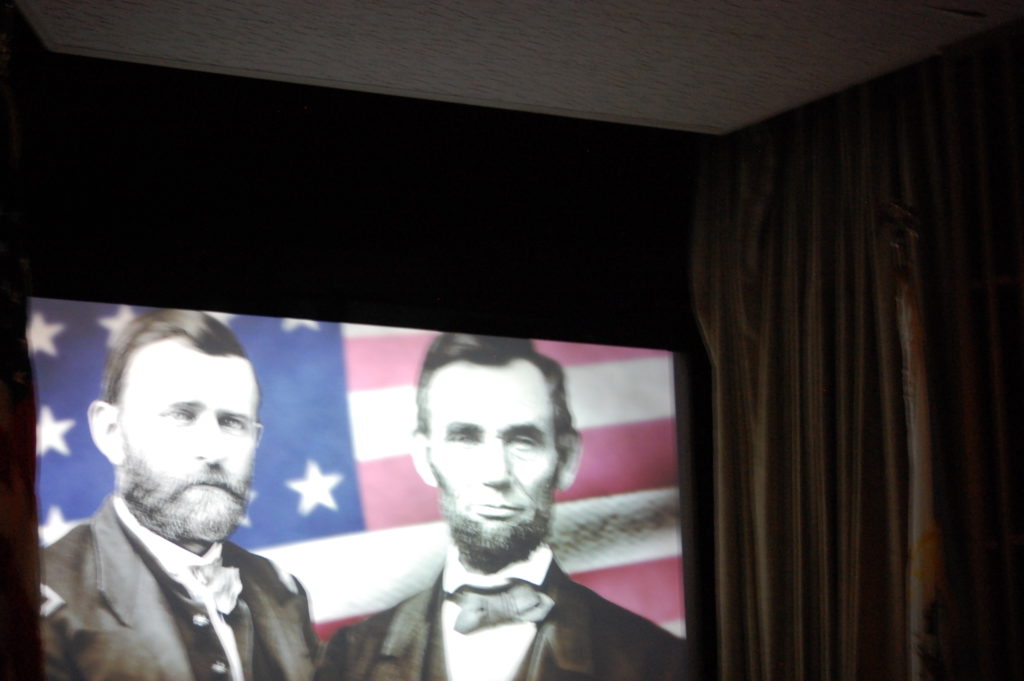
The surrender meeting happened in April but prior to that Grant and President Lincoln had a meeting. In that meeting had asked General Grant to be considerate to General Lee. They both knew that the Lee surrender was going to happen the question was how much longer. The Confederates were basically starved into surrendering. It was Lincoln’s attitude that the surrender terms would go along way in re-unifying the country. Lee had only two personal choices; win or disperse his army. A result of dispersing all his troops would reek havoc on the locals. He wanted a good outcome that his men could accept willingly. The only choice was to contemplate surrender.
The terms would parole officers and enlisted men but required that all Confederate military equipment be relinquished. The discussion between the generals then drifted into the prospects for peace, but Lee, once again taking the lead, asked Grant to put his terms in writing.
Some of the other room in this historic home. Most of all the furniture is authentic to the house.
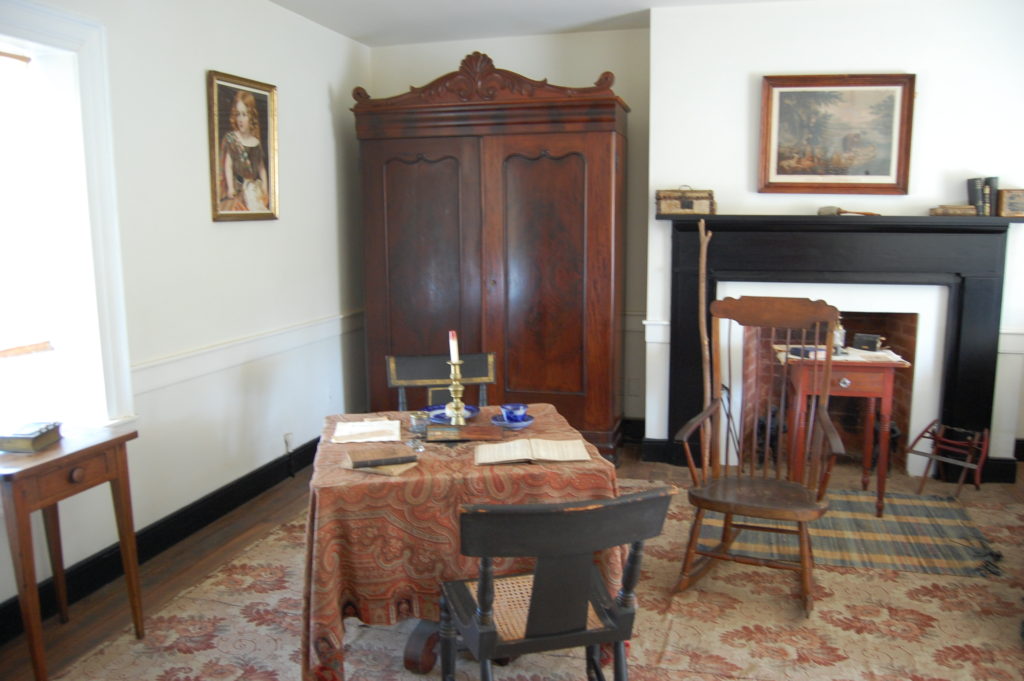
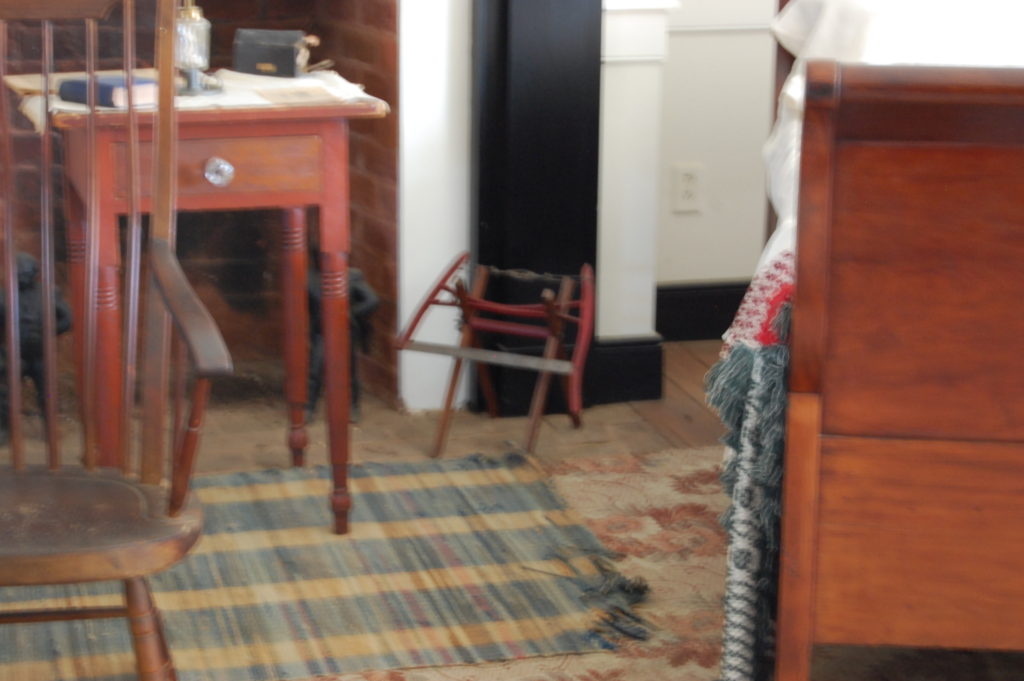
This is a personal likeable picture. The unit is so small that unless you were looking for it you might not see it. It’s a scaled down wood cutting table with saw for the nearby fireplace” FYI!
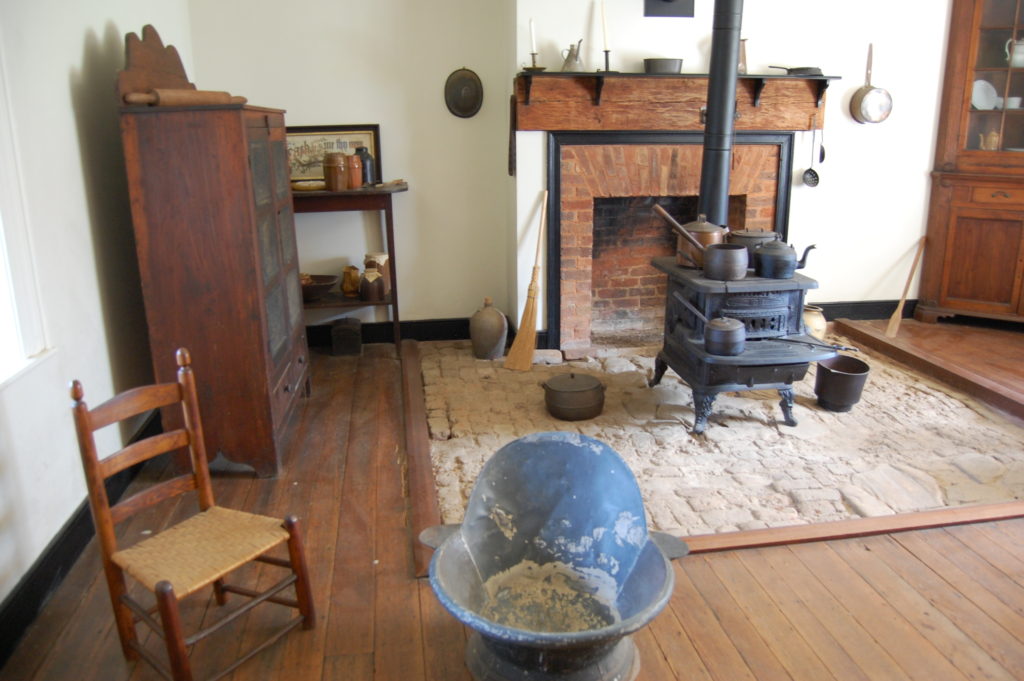
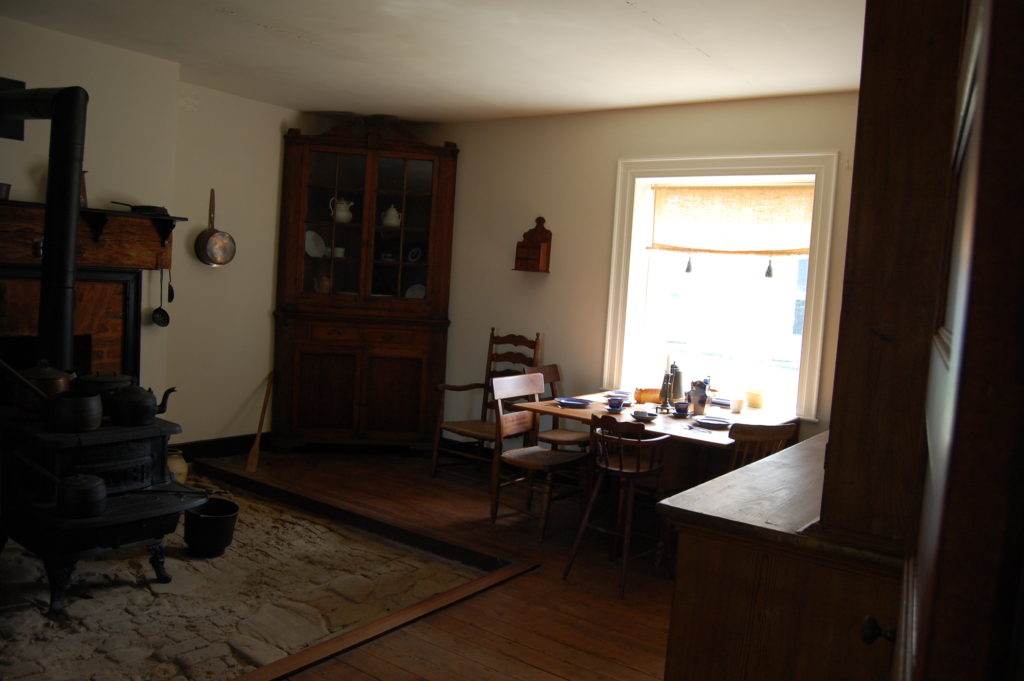
Below is the formal eating area with the best of the family dishware. Above is reality. This is where the family, most likely, ate most of their meals. This is a “Neo-Clasical” home, meaning that as you climbed all those stairs in the front of the house you actually walked in onto the second floor of the home. The dining table above would be found on the bottom level.
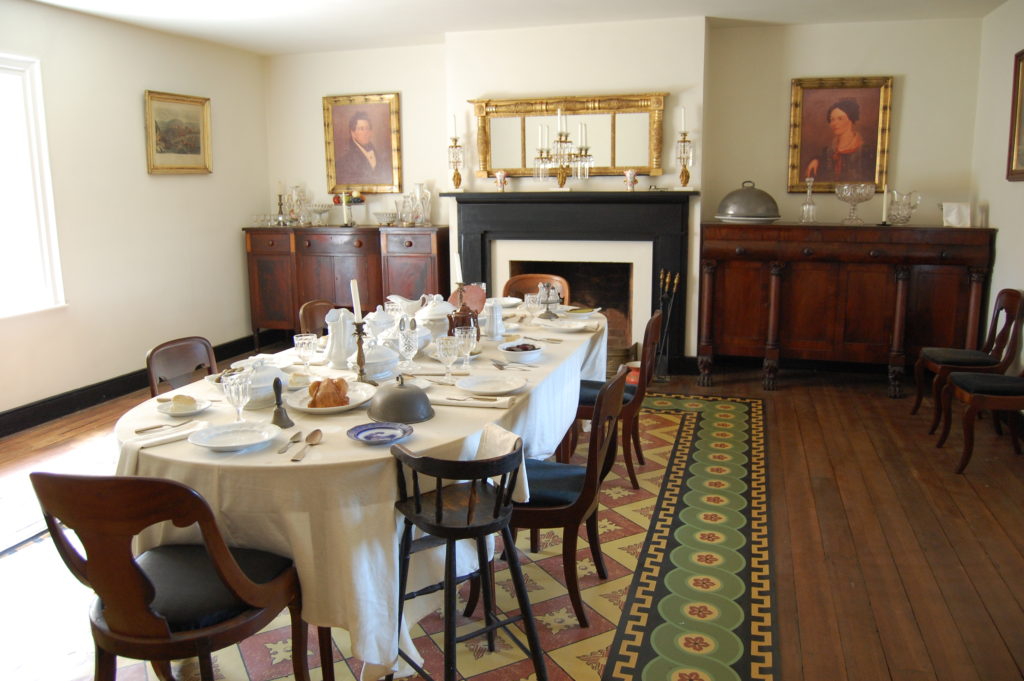
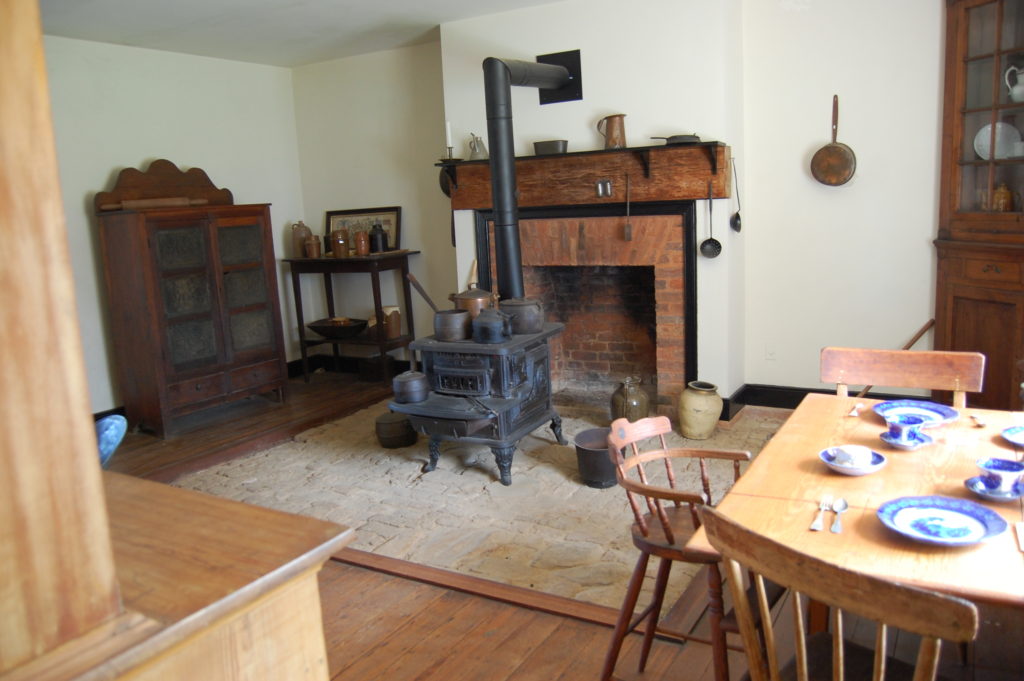
Once again above is the informal eating area. Below is the kitchen. In that time-period it would be normal to find the kitchen area located to the side of the home. The reason for this would be in case of fire.
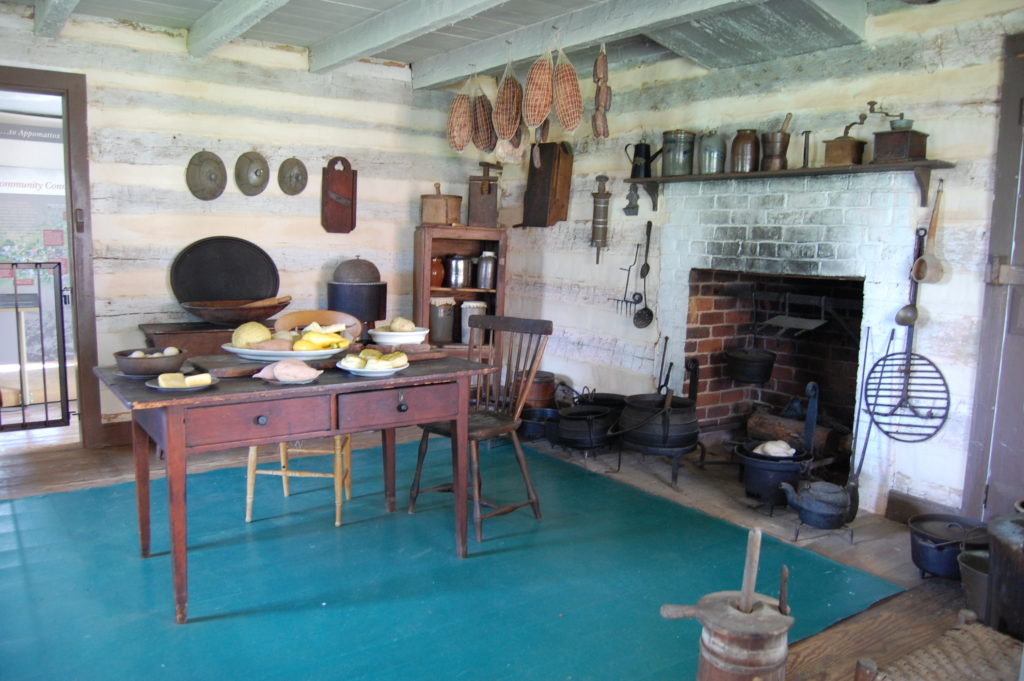
When Grant finished, he handed the terms to his former adversary, and Lee — first donning spectacles used for reading– quietly looked them over.
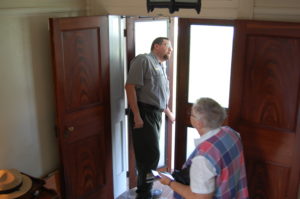 This picture, to the left, only merits a small entry since the NPS person was just there to be helpful so Carla needed some help on the local bugs. As his dissertation went on he got into kitchens. Having been exposed to this information years ago with our Gettysburg trip on how and why kitchens were not usually part of the living portions of a typical home, he began talking about fires. He mentioned the majority of fire related burnings began in the kitchen. He then went further on to say; the majority of deaths for women were related to fire. The heavy clothing with multiple layers made it very difficult for a woman on fire to disrobe and shed her clothing in order to save herself, sad!
This picture, to the left, only merits a small entry since the NPS person was just there to be helpful so Carla needed some help on the local bugs. As his dissertation went on he got into kitchens. Having been exposed to this information years ago with our Gettysburg trip on how and why kitchens were not usually part of the living portions of a typical home, he began talking about fires. He mentioned the majority of fire related burnings began in the kitchen. He then went further on to say; the majority of deaths for women were related to fire. The heavy clothing with multiple layers made it very difficult for a woman on fire to disrobe and shed her clothing in order to save herself, sad!
When he finished reading, the bespectacled Lee looked up at Grant and remarked “This will have a very happy effect on my army.” Lee asked if the terms allowed his men to keep their horses, for in the Confederate army men owned their mounts. Lee explained that his men would need these animals to farm once they returned to civilian life.
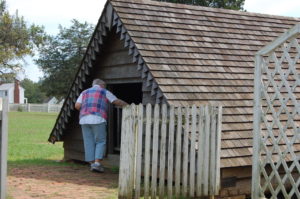 Once again, I asked the NPS gentleman, about the little teepee structure to the left of the main home. (For what it’s worth, I already knew the answer.) I knew he would tell us that this structure was used to preserve foods keeping them cool by letting a stream of water flow through the structure. He was nice very forth coming with his answer. It was an “ice house.” That’s not what I had expected and I told him. He confirmed my understanding but enlightened me by explaining that Virginia has very few underground streams do to all the rock, slate and marble in the ground, therefore no stream cooling. Inside the ice house a hole would be dug, possibly as deep as 20 to 24 feet deep. During the winter season chunks of ice would be cut up and carried to the ice house. Once filled with enough ice to last the hot summer months the ice would be covered with hay to shield the ice from the summer heat.
Once again, I asked the NPS gentleman, about the little teepee structure to the left of the main home. (For what it’s worth, I already knew the answer.) I knew he would tell us that this structure was used to preserve foods keeping them cool by letting a stream of water flow through the structure. He was nice very forth coming with his answer. It was an “ice house.” That’s not what I had expected and I told him. He confirmed my understanding but enlightened me by explaining that Virginia has very few underground streams do to all the rock, slate and marble in the ground, therefore no stream cooling. Inside the ice house a hole would be dug, possibly as deep as 20 to 24 feet deep. During the winter season chunks of ice would be cut up and carried to the ice house. Once filled with enough ice to last the hot summer months the ice would be covered with hay to shield the ice from the summer heat.
Grant responded that he would not change the terms as written (which had no provisions allowing private soldiers to keep their mounts) but would order his officers to allow any Confederate claiming a horse or a mule to keep it. General Lee agreed that this concession would go a long way toward promoting healing. Grant’s generosity extended further.
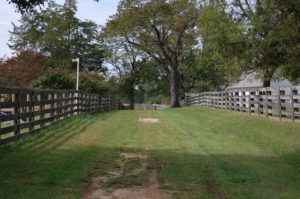
The partially grassy area in the center of the picture is the original Lynchburg to Richmond Road. Why is this worth mentioning? In order to get to either destination you had to go through Appomattox. For years this brought a great deal of commerce and settlers to Appomattox, until! The railroad. Prior to the railroad taverns, eateries and rooms to board were all doing a very nice business. ( Just think of it, in 1865 sixty-five thousand Union troops walked down this road to Appomattox.)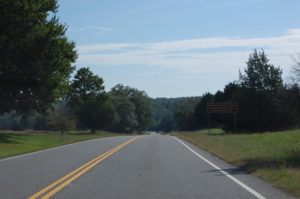
The towns folks fought bitterly to have the train station located in this general area, but the powers to be had their own opinion. The RR Station would be three miles from this location. Three miles may not seem that much since we can drive there in about five minutes but back then people had to walk. Mot everyone on the train would, from that time on, stay on the train until their destination, and the town had to remake itself. The picture below is the current Lynchburg to Richmond Road. Needless to say both Lynchburg and Richmond grew exponentially thanks to the railroad.
When Lee mentioned that his men had been without rations for several days, the Union commander arranged for 25, 000 rations to be sent to the hungry Confederates.
In addition to feeding the Confederate Soldiers, this day since they were hungry, this parole pass would permit them to eat at no charge at any and all government installations these soldiers came across as they made their way back home.
After formal copies of the surrender terms, and Lee’s acceptance, had been drafted and exchanged, the meeting ended.
Before he met with General Grant, one of Lee’s officers (General E. Porter Alexander) had suggested fighting a guerilla war, but Lee had rejected the idea. It would only cause more pain and suffering for a cause that was lost. The character of both Lee and Grant was of such a high order that the surrender of the Army of Northern Virginia has been called “The Gentlemen’s Agreement.”
The Emancipation Proclamation was signed by Lincoln a couple of years ago and the South was not accepting it. This surrender hopefully would unify the North and South and hopefully allow the Emancipation Proclamation to be further enacted. Lincoln would not live to see this happen. Only two days after the signing President Lincoln would be assassinated.
Courtesy of the National Park service
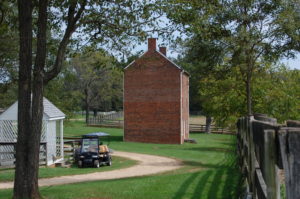

The McLean home. This was the local jail.
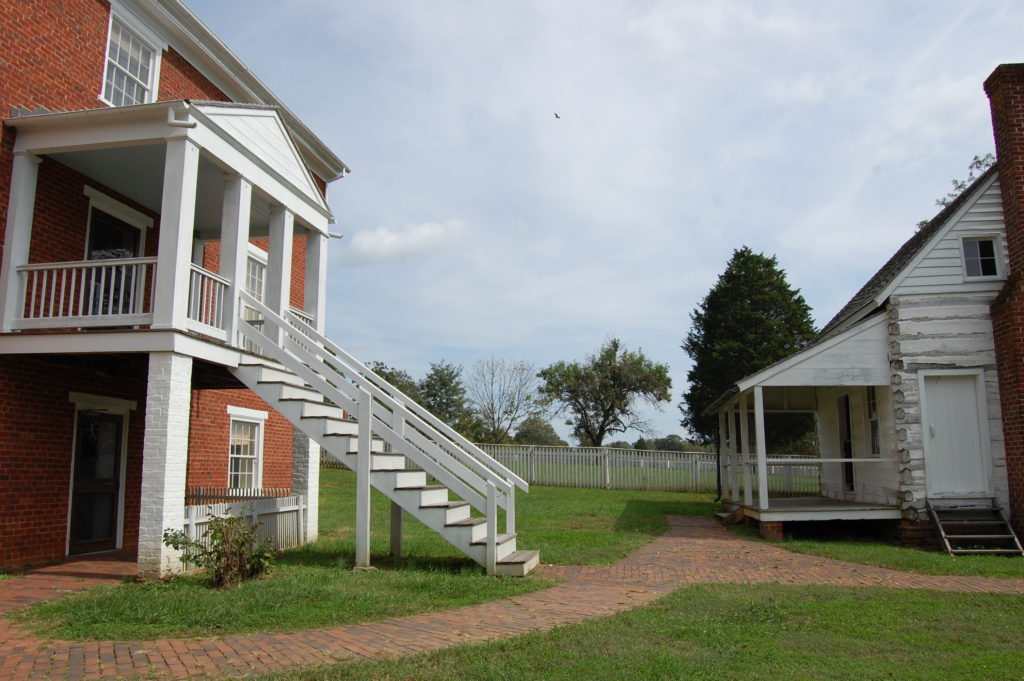 Another picture of the County Courthouse with its Knee and hip killing steps.
Another picture of the County Courthouse with its Knee and hip killing steps.
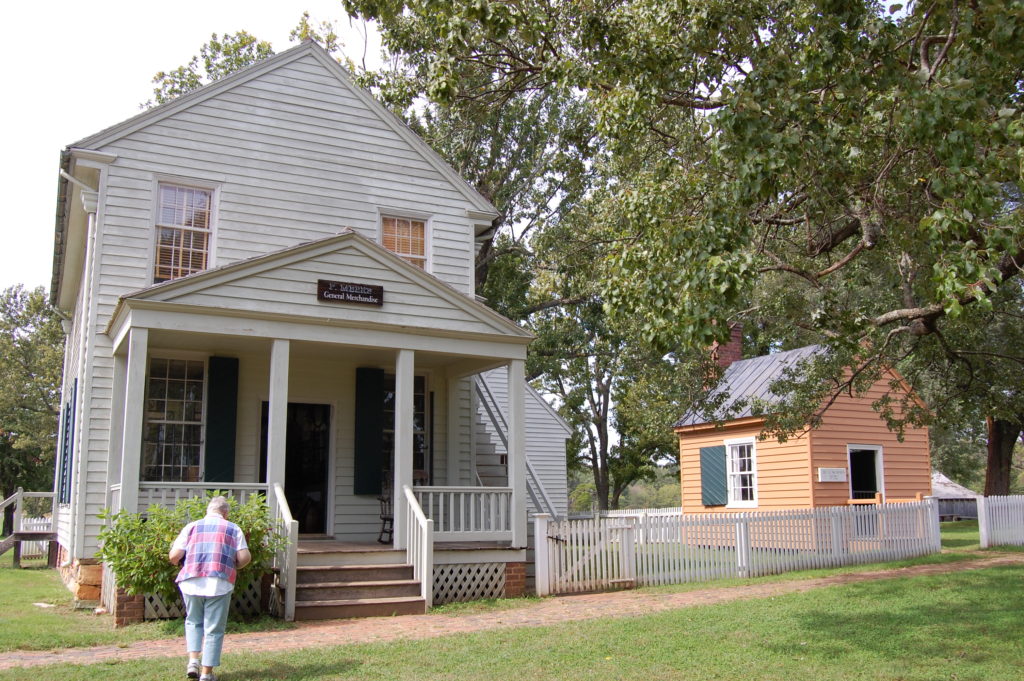 This would be the General Store, and then some. It’s a regular Ace Hardware Place.
This would be the General Store, and then some. It’s a regular Ace Hardware Place. 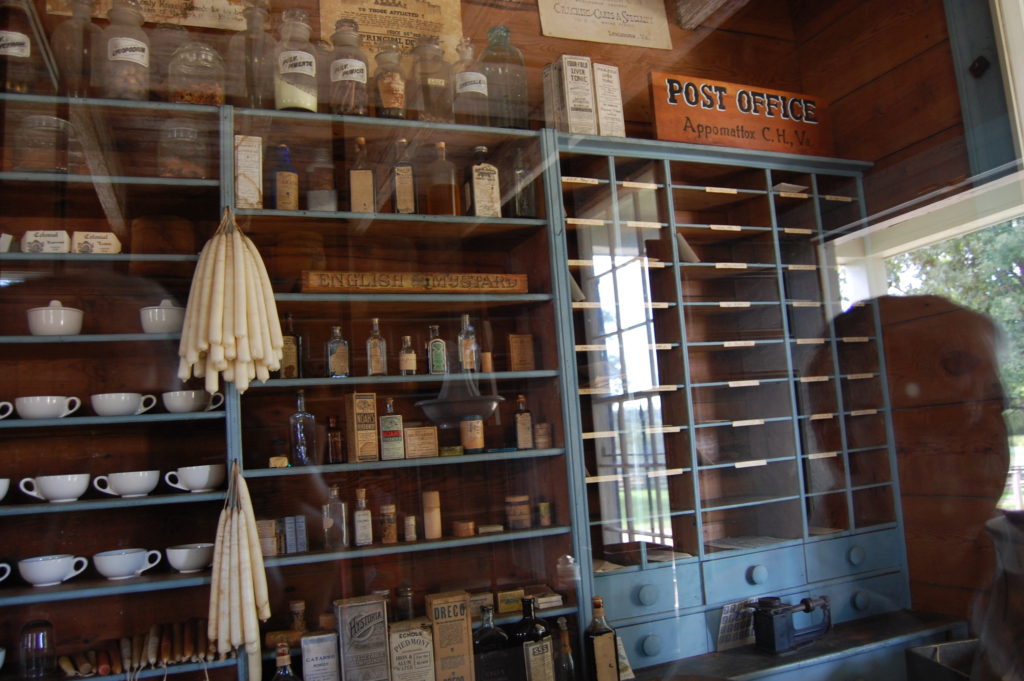
Yes, this is also the post office as well as a Pharmacy. The little yellow shed to the right is an attorney’s office.
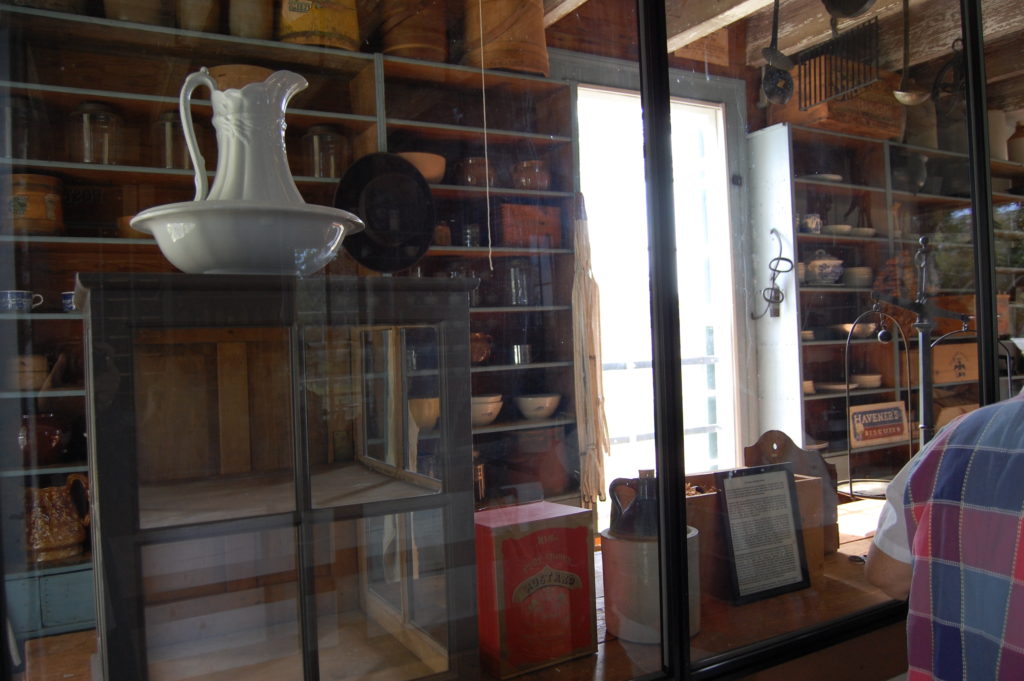
All kinds of stuff from dishes to fireplace needs, even some farming supplies.
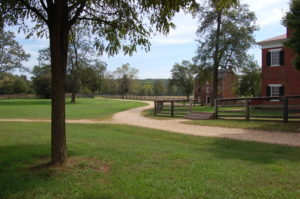
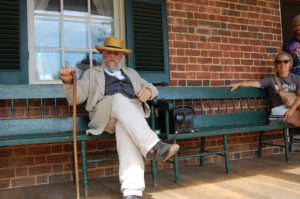 Once again, the Lynchburg/Richmond road right through the center of Appomattox. The gentleman above is a retired doctor with a great deal of time on his hands. We sat and tolerated him for twenty minutes and he was still asking folks who they were and where they came from. If I wasn’t certain that the Kentucky Fried Chicken Colonel had died, I’d be certain this was he.
Once again, the Lynchburg/Richmond road right through the center of Appomattox. The gentleman above is a retired doctor with a great deal of time on his hands. We sat and tolerated him for twenty minutes and he was still asking folks who they were and where they came from. If I wasn’t certain that the Kentucky Fried Chicken Colonel had died, I’d be certain this was he.
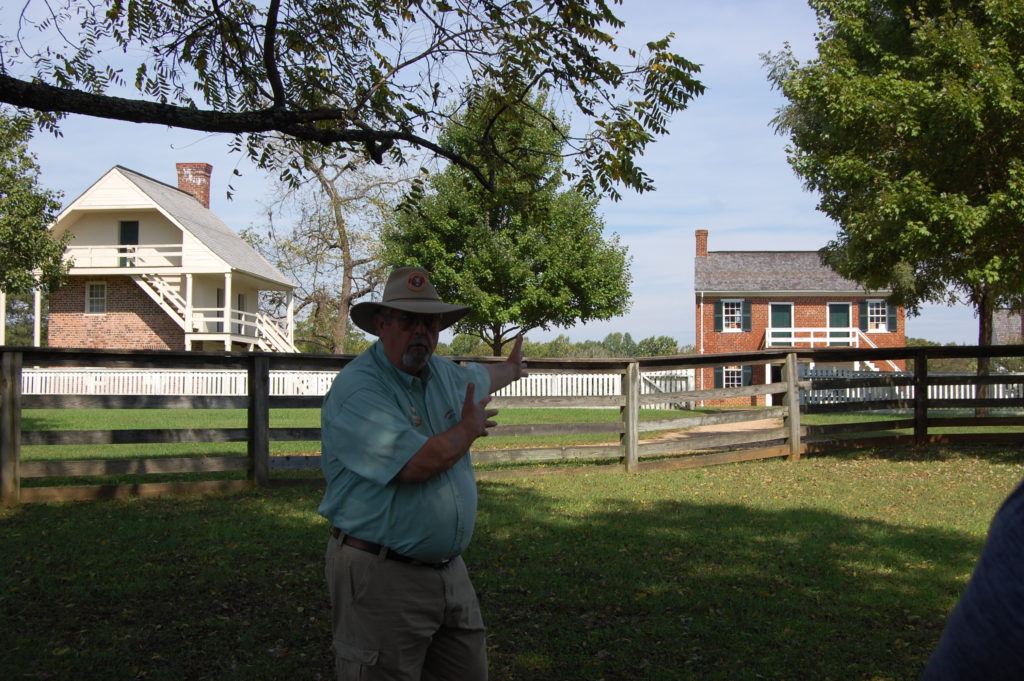
This volunteer was really good. Got right to the facts. He saw that most of us were seniors and we did not have time to spare. He went into just enough detail, but not overly so, to paint an awesome picture about the logistics of the Union forces and of course the confederates as well as the impact the railroad had on the town. He was a pleasure to listen to.